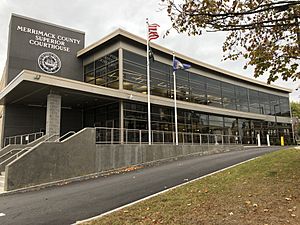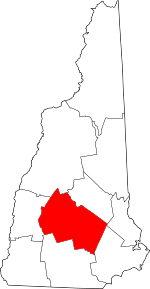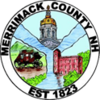Merrimack County, New Hampshire facts for kids
Quick facts for kids
Merrimack County
|
||
|---|---|---|

Merrimack County Courthouse, 2019
|
||
|
||

Location within the U.S. state of New Hampshire
|
||
 New Hampshire's location within the U.S. |
||
| Country | ||
| State | ||
| Founded | 1823 | |
| Named for | Merrimack River | |
| Seat | Concord | |
| Largest city | Concord | |
| Area | ||
| • Total | 955.0 sq mi (2,473 km2) | |
| • Land | 932.9 sq mi (2,416 km2) | |
| • Water | 22.1 sq mi (57 km2) 2.3% | |
| Population
(2020)
|
||
| • Total | 153,808 | |
| • Estimate
(2022)
|
156,020 |
|
| • Density | 167.2/sq mi (64.6/km2) | |
| Time zone | UTC−5 (Eastern) | |
| • Summer (DST) | UTC−4 (EDT) | |
| Congressional districts | 1st, 2nd | |
Merrimack County is a county in the U.S. state of New Hampshire. As of the 2020 Census, the population was 153,808, making it the third most populous county in New Hampshire. Its county seat is Concord, the state capital. The county was organized in 1823 from parts of Hillsborough and Rockingham counties, and is named for the Merrimack River. Merrimack County comprises the Concord, NH Micropolitan Statistical Area, which in turn constitutes a portion of the Boston–Worcester–Providence, MA–RI–NH–CT Combined Statistical Area. In 2010, the center of population of New Hampshire was located in Merrimack County, in the town of Pembroke.
Contents
Geography
According to the United States Census Bureau, the county has a total area of 956 square miles (2,480 km2), of which 934 square miles (2,420 km2) is land and 22 square miles (57 km2) (2.3%) is water. It is the third largest county in New Hampshire by land area. The highest point in Merrimack County is Mount Kearsarge, on the border of Warner and Wilmot, at 2,937 feet (895 m).
Adjacent counties
- Belknap County (northeast)
- Strafford County (east)
- Rockingham County (southeast)
- Hillsborough County (south)
- Sullivan County (west)
- Grafton County (northwest)
National protected area
Demographics
| Historical population | |||
|---|---|---|---|
| Census | Pop. | %± | |
| 1830 | 34,614 | — | |
| 1840 | 36,253 | 4.7% | |
| 1850 | 40,337 | 11.3% | |
| 1860 | 41,408 | 2.7% | |
| 1870 | 42,151 | 1.8% | |
| 1880 | 46,300 | 9.8% | |
| 1890 | 49,435 | 6.8% | |
| 1900 | 52,430 | 6.1% | |
| 1910 | 53,335 | 1.7% | |
| 1920 | 51,770 | −2.9% | |
| 1930 | 56,152 | 8.5% | |
| 1940 | 60,710 | 8.1% | |
| 1950 | 63,022 | 3.8% | |
| 1960 | 67,785 | 7.6% | |
| 1970 | 80,925 | 19.4% | |
| 1980 | 98,302 | 21.5% | |
| 1990 | 120,005 | 22.1% | |
| 2000 | 136,225 | 13.5% | |
| 2010 | 146,445 | 7.5% | |
| 2020 | 153,808 | 5.0% | |
| 2022 (est.) | 156,020 | 6.5% | |
| U.S. Decennial Census 1790–1960 1900–1990 1990–2000 2010–2020 |
|||
2010 census
As of the census of 2010, there were 146,445 people, 57,069 households, and 38,104 families living in the county. The population density was 156.8 inhabitants per square mile (60.5/km2). There were 63,541 housing units at an average density of 68.0 per square mile (26.3/km2). The racial makeup of the county was 95.3% white, 1.6% Asian, 1.0% black or African American, 0.3% American Indian, 0.3% from other races, and 1.4% from two or more races. Those of Hispanic or Latino origin made up 1.6% of the population. In terms of ancestry, 20.5% were English, 20.4% were Irish, 10.1% were German, 9.7% were Italian, 9.7% were French Canadian, 5.2% were Scottish, and 4.9% were American.
Of the 57,069 households, 31.3% had children under the age of 18 living with them, 52.4% were married couples living together, 9.9% had a female householder with no husband present, 33.2% were non-families, and 25.4% of all households were made up of individuals. The average household size was 2.46 and the average family size was 2.94. The median age was 41.4 years.
The median income for a household in the county was $63,012 and the median income for a family was $75,268. Males had a median income of $50,880 versus $37,351 for females. The per capita income for the county was $30,544. About 5.2% of families and 8.1% of the population were below the poverty line, including 10.6% of those under age 18 and 7.4% of those age 65 or over.
Communities
Cities
Towns
Census-designated places
Villages
Education
School districts include:
K-12 districts:
- Bow School District
- Concord School District
- Franklin School District
- Hopkinton School District
- Kearsarge Regional School District
- Merrimack Valley School District
- Newfound Area School District
- Pembroke School District
- Pittsfield School District
- Shaker Regional School District
- Winnisquam Regional School District
Secondary districts:
- John Stark Regional School District
Elementary districts:
- Allenstown School District
- Andover School District
- Chichester School District
- Dunbarton School District
- Epsom School District
- Henniker School District
- Hill School District
- Hooksett School District
Hooksett sends its high school students to Pinkerton Academy, a privately endowed publicly funded high school in Derry, Rockingham County. Previously Hooksett sent high school students to the Manchester School District.
See also
 In Spanish: Condado de Merrimack (Nuevo Hampshire) para niños
In Spanish: Condado de Merrimack (Nuevo Hampshire) para niños


